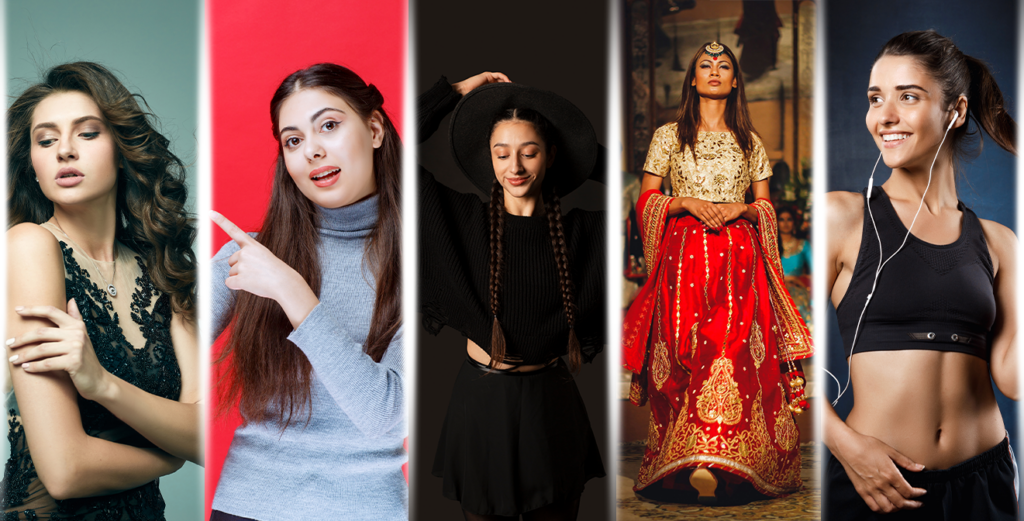10 Different Types Of Modelling You Can Choose As A Career

Modelling- a career that has been around since the last century and has been entertaining people for ages in different forms.
But, when you hear the term modelling, your first thought is to imagine a 6ft attractive model doing a catwalk somewhere on a ramp in a city full of fashion and entertainment.
However, modeling is much more than simply catwalks and unrealistic physique standards.
There are different types of modeling. Modelling is one of those jobs where you apply your talent and skills in a very specific and creative manner. As a model, you also have the freedom to experiment with your looks depending on the industry you’re working for.
As a model in the fashion industry, you have to be open-minded at the start of your profession. Over time, you will get more familiar with the many forms of modeling. There are numerous unique models in the fashion world, and you may be the next great thing in one (or more!) area of modeling.
Read More: Modelling Career
Here are 10 types of modelling careers you can explore.
1. Fashion Modelling
Fashion modeelling is all about walking the runway, showcasing luxury designer clothing. They are also employed to conduct editorial work. In the fashion industry, editorials are still photographs of fashion models dressed in luxury clothing. These appear in magazines that mainly focus on fashion, like Vogue, Elle, W, etc.
2. Runway Modelling
The models in runway modelling appear on the catwalk and are recruited to promote a designer’s clothes line. Because of the precise proportions of the designer’s apparel, runway models are frequently a specific height and size. If you are at least 5’9″, this form of modeling may be for you.
3. Swimsuit & Lingerie Modelling
These models specialize in displaying either swimsuits or lingerie. This model tends to be more curvaceous. These models are also known to model sleepwear, summer wear, and other types of undergarments.
4. Commercial Modelling
Commercial modeling is divided into several areas, such as catalog, fit, and editorial modelling. Commercial models are the gorgeous, “real”-looking people you see in advertisements.
Commercial modeling opportunities exist for people of all ages and body types. There are several commercial modeling jobs available, ranging from lifestyle catalogs to medical commercials.
Many great commercial models are actors; if you can portray numerous layers of emotion to the camera, you might be a good fit for this role.
5. Fitness Modelling
The models in fitness modelling are typically the fittest, toned, and athletically built. This is logical, given that these models are supposed to be wearing workout clothes. Fitness models are also seen in commercials demonstrating fitness practices.
6. Parts Modelling
The Models in parts modelling focuses on modeling specific body parts such as hands, arms, feet, and legs. Hand models often find opportunities in the jewelry industry, while foot models may work with shoe companies.
Both can also find work in nail and beauty care. Clients typically prefer models with well-proportioned body parts that fit standard shoes and jewelry.
7. Fit Modelling
The models in fit modelling are not featured in advertisements. Their job is to assist the designer and manufacturer in determining how sizes fit on the human body before the item is made. Models can find stable work in this type of job.
8. Promotional Modelling
Promotional models are typically engaged in live events, trade exhibitions, and conventions. Jobs can include pretending to be a patient at a medical exhibition, gathering attendees to bring to a firm’s booth, and giving company information.
9. Glamour Modelling
Glamour modeling focuses on appearance, such as facial beauty and body shape. These models are typically curvier than magazine models and frequently book bikini and lingerie photoshoots. Glamour models pose more actively than regular editorial or commercial models.
10. Print Modelling
The print modelling models are commonly seen in publications, billboards, campaigns, pamphlets, leaflets, and posters. These models typically have clear skin and a pleasant smile. While some of these models are marketing a product, others are merely being photographed to meet the client’s demands.
About modelling jobs
After discussing about different types of modelling, here are some insights on modelling jobs and how to get a job as a model:
Modeling is a great career for people who look good and have a nice body. But if you’re new to it, it can be hard to find jobs. Here’s how to start:
Make a portfolio: Take pictures of yourself in different poses and outfits to show to potential employers. You can use the services of Diffr to make a good portfolio to showcase your best work.
Join a modeling agency: Look for agencies in your city and ask them if they need models. Use social media: Reach out to famous models and people who hire models on sites like Instagram or Diffr. They often post about jobs there.
Be active online: If you have a lot of followers on Instagram or Facebook, companies might notice you and want to hire you as a model. Posting pictures of yourself can help show off your work.
Read More : How To Build An Acting Portfolio? Tips & Tricks
FAQ
There are 10 types of modeling Fashion Modelling, Fashion (Catalog Modelling) Modelling, Runway Modelling, Commercial Modelling, Mature Modelling, Promotional Modelling, Parts Modelling, Fit Modelling, Fitness Modelling, and Glamour Modelling etc. are some of the types of modelling.
High fashion modeling has the highest pay rates, with top models making considerable sums from runway shows, fashion campaigns, and endorsements. Commercial modeling, particularly in the beauty, lifestyle, and luxury categories, can also be profitable.
Profile means your portfolio, where you showcase facts such as height, measurements, and experience. It also shows your other physical features that help you get work in the industry.
There is no fixed income when it comes to modeling. It depends on where you are working, for which sector you are working, and with which agency you are working. You can even earn crores per year or maybe even lakhs per project influenced by industry, city, projects, etc. But a model can averagely earn 1–5 lakhs per month, according to an industry expert.
There is no age limit when it comes to modelling as long as you are fit, maintain yourself, and are still relevant in the industry.




